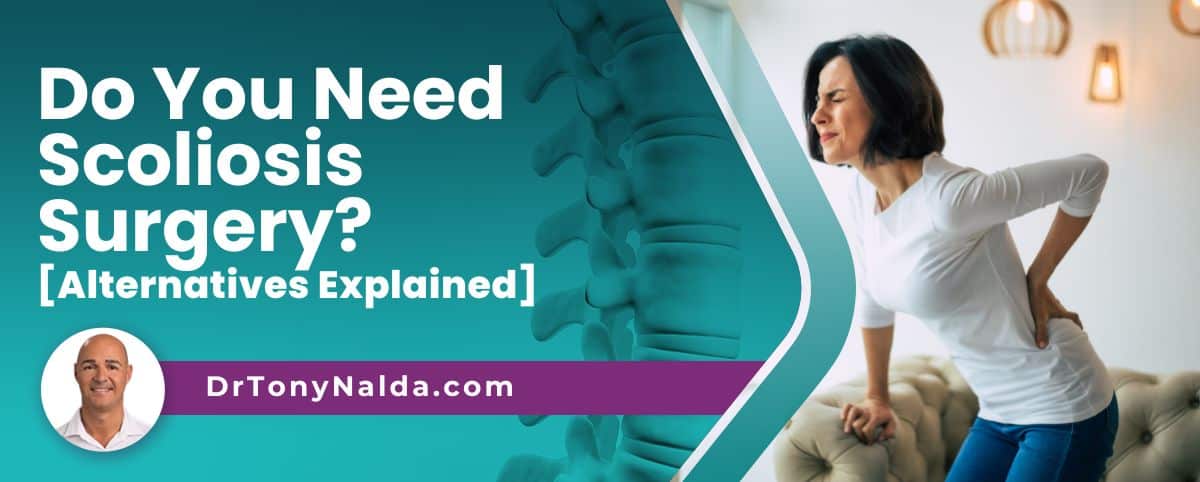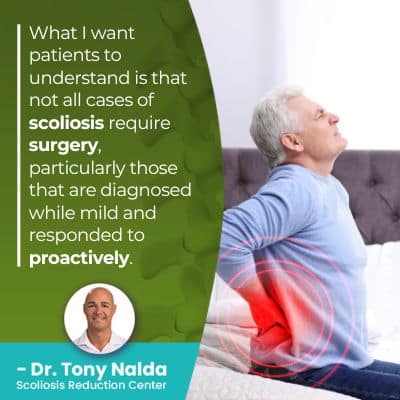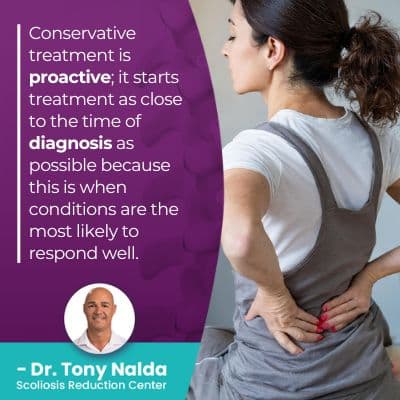Do You Need Scoliosis Surgery? [Alternatives Explained]

Following a scoliosis diagnosis, the most important decision patients have to make is how to treat the condition; different treatment approaches offer patients different potential outcomes that shape long-term spinal health and function. Traditional scoliosis surgery can straighten a bent spine, but it can cost the spine in other ways, while modern conservative treatment offers a nonsurgical treatment alternative.
There is more than one way to treat scoliosis, and the two main options are surgical or nonsurgical treatment. There was a time when traditional surgical treatment was the dominant choice, but many cases of scoliosis don't require surgery, and nonsurgical options are less invasive.
Different scoliosis treatment approaches respond to diagnoses in their own way; let's start with why that matters.
Table of Contents
Being Diagnosed with Scoliosis
Being diagnosed with scoliosis means an unnatural sideways and rotating spinal curvature has developed, and this introduces a lot of uneven forces to the spine, its surroundings, and the entire body.
How a diagnosis of scoliosis is responded to is key because as a progressive spinal condition that's virtually guaranteed to get worse at some point, the best time to start scoliosis treatment is always now.
Scoliosis ranges widely in severity from mild scoliosis to moderate, severe, and very severe scoliosis, and this is also the condition's progressive line.
The more scoliosis progresses, the more complex it gets to treat; as the size of the scoliotic curve gets larger, the spine gets increasingly rigid, making it less responsive to treatment and making it difficult for some patients to perform certain therapeutic exercises that are key to treatment.
As scoliosis progresses, the condition is getting more severe, and its effects tend to get more noticeable; in children, the main effects involve postural changes, and in adults, the most-noticeable scoliosis symptom is pain.
How a diagnosis is responded to with treatment is important; while treatment results can never be guaranteed, early detection and intervention is associated with treatment success, but the benefits of early detection are only available to those whose diagnosis is met with a proactive treatment response.
With progressive conditions like scoliosis, sometimes when treatment is started can be as important as the type of treatment started.
Traditional versus Conservative Treatment
The two main types of treatment are traditional and conservative, and scoliosis is a structural spinal condition that's been around since ancient times.
Traditional scoliosis treatment was the dominant response for many years, and this includes spinal fusion, but that doesn't mean it was the best or only treatment option available.
Traditional treatment is more reactive than proactive, and when it comes to addressing progressive conditions like scoliosis, this is an important distinction.
Even though the milder scoliosis is, the simpler it is to treat, traditional scoliosis treatment doesn't have a strategy for addressing scoliosis while mild, so is known to respond to a diagnosis of mild scoliosis with the recommendation to watch and wait.
Watching and waiting for signs of continued progression, to me, is wasting valuable treatment time because as a progressive condition, virtually every case is going to get worse, so merely observing a condition can mean allowing it to get worse unimpeded.
Traditional treatment commonly recommends returning for periodic examinations and X-ray imaging, but this can be dangerous because growth is what triggers scoliosis to progress.
Adolescent idiopathic scoliosis, diagnosed between the ages of 10 and 18, is the most prevalent type of scoliosis, and this age group is the most at risk for scoliosis progressing rapidly because of the rapid and unpredictable growth spurts associated with puberty.
What can happen is that in between assessments, a young patient can have a significant growth spurt and experience significant progression as a result, making the condition more complex to treat, and funneling patients towards spinal fusion surgery which is a lengthy, costly, and invasive spinal surgery.
Scoliosis Surgery
 There are different types of spinal fusion surgery, but most often, the procedure involves fusing the curve's most-tilted vertebrae into one solid bone to eliminate movement (progression) and attaching rods to the spine with pedicle screws to hold it in place.
There are different types of spinal fusion surgery, but most often, the procedure involves fusing the curve's most-tilted vertebrae into one solid bone to eliminate movement (progression) and attaching rods to the spine with pedicle screws to hold it in place.
Spinal fusion surgery is commonly recommended to those on the path of traditional treatment when/if a patient progresses into the severe scoliosis classification.
Condition severity is determined by a patient's Cobb angle measurement, and the higher a Cobb angle measurement, the further out of alignment the spine is, and the more severe the condition:
- Mild scoliosis: Cobb angle measurement of between 10 and 25 degrees
- Moderate scoliosis: Cobb angle measurement of between 25 and 40 degrees
- Severe scoliosis: Cobb angle measurement of 40+ degrees
- Very-severe scoliosis: Cobb angle measurement of 80+ degrees
If a scoliosis patient becomes severe, and traditional bracing (associated with a number of shortfalls) has been unsuccessful at stopping progression, spinal fusion surgery is commonly recommended as the best, and only, remaining treatment option.
What I want patients to understand is that not all cases of scoliosis require surgery, particularly those that are diagnosed while mild and responded to proactively.
Risks associated with the procedure of spinal fusion can include:
- Nerve damage
- Excessive blood loss
- Adverse reaction to hardware used
- Infection
Side effects and potential complications of living with a fused spine can include:
- A noticeable loss in spinal flexibility and range of motion
- Increased pain at the fusion site
- Hardware malfunction over time
- A spine that's weaker and more vulnerable to injury
Spinal fusion can straighten a bent spine and hold it in place, but the way it does so is contrary to the spine's natural movement-based design, so costs the spine in terms of its overall strength, health, and function, but nonsurgical treatment offers a less-invasive treatment alternative.
Conservative Nonsurgical Treatment
Conservative nonsurgical treatment is what patients of the Scoliosis Reduction Center benefit from, and it's a modern integrative approach that has a number of benefits when it comes to long-term spinal health and function.
Conservative treatment is proactive; it starts treatment as close to the time of diagnosis as possible because this is when conditions are the most likely to respond well.
Conservative treatment works towards preventing progression by starting treatment as early as possible; in many cases, it's more effective to proactively work towards preventing progression and increasing condition effects than it is to attempt to reverse effects once they're established.
Condition-specific chiropractic care, physical therapy, corrective bracing, and rehabilitation work together to impact conditions on every level with the goal of correcting scoliosis, not just stopping it from getting worse.
Chiropractic Care
 Chiropractic care involves a series of techniques and manual adjustments that can work towards realigning the spine by adjusting the position of the curve's most-tilted vertebrae; this is impacting the condition's underlying structural nature.
Chiropractic care involves a series of techniques and manual adjustments that can work towards realigning the spine by adjusting the position of the curve's most-tilted vertebrae; this is impacting the condition's underlying structural nature.
Physical Therapy
Physical therapy and scoliosis-specific exercise works towards strengthening the back muscles for improved spinal support/stabilization, improving posture, and activating specific areas of the brain for improved brain-body communication.
Corrective Bracing
Corrective bracing is particularly effective on growing spines so is a regular facet of treatment for adolescent idiopathic scoliosis and can help augment corrective treatment results by pushing the spine into a corrective position.
Rehabilitation
Rehabilitation is necessary to sustain treatment results, and this can involve continued chiropractic care, and/or series of custom-prescribed scoliosis-specific therapeutic exercises performed from home so patients can continue to heal and stabilize their spines for long-term treatment results.
Conclusion
Spinal fusion surgery can be necessary for severe and/or atypical forms of scoliosis, and while there are never treatment guarantees, particularly with early detection and intervention, I want patients to know that nonsurgical treatment also offers impressive results.
Spinal fusion, like all surgical options, comes with its share of potential risks, side effects, and complications, and even when successful at stopping scoliosis progression, scoliosis surgery can disrupt the spine's long-term strength and function.
Nonsurgical conservative treatment has the goal of preserving as much of the spine's natural strength and function as possible so is more aligned with its movement-based design; holding the spine in a straighter position through artificial means is not the same as working towards achieving corrective results by impacting the condition's underlying structural nature.
When a diagnosis of scoliosis is responded to with a proactive and customized treatment plan, there are fewer limits to what can be achieved, and that includes preventing progression, increasing condition effects, and the need for more-invasive surgical options.
Here at the Center, patients benefit from treatment that's started as close to the time of diagnosis as possible; most patients are going to respond better to treatment started early in the condition's progressive line, when scoliosis is the most treatable.
Dr. Tony Nalda
DOCTOR OF CHIROPRACTIC
After receiving an undergraduate degree in psychology and his Doctorate of Chiropractic from Life University, Dr. Nalda settled in Celebration, Florida and proceeded to build one of Central Florida’s most successful chiropractic clinics.
His experience with patients suffering from scoliosis, and the confusion and frustration they faced, led him to seek a specialty in scoliosis care. In 2006 he completed his Intensive Care Certification from CLEAR Institute, a leading scoliosis educational and certification center.
About Dr. Tony Nalda
 Ready to explore scoliosis treatment? Contact Us Now
Ready to explore scoliosis treatment? Contact Us Now





